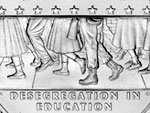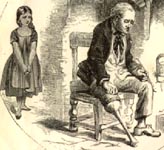This website features 4th graders analyzing two political cartoons from the Richmond Times-Dispatch about Virginia's reaction to the Brown v. Board of Education Supreme Court decision. This standards-based lesson guides students in exploring the Virginia state policy of massive resistance to school desegregation. This video provides examples of two promising practices:
- Modeling careful analysis of a primary source while practicing historical thinking with young students;
- Using scaffolding and concrete instructional strategies to guide students in shaping meaning out of multiple primary sources.
The Lesson in Action
Video of the lesson shows the teacher modeling primary source analysis with the first cartoon and students working in pairs to interpret a second on their own. Both cartoons—one published in 1954 and the other in 1958—are drawn by Fred O. Siebel. They use similar imagery and symbolism, helping students analyze the second cartoon and compare the two. Through effective scaffolding and modeling of historical thinking skills, the teacher engages students in thinking about complex historical questions of equality, fairness, and the power of federal and state governments. The lesson concludes with a class discussion of each group's findings and what their analysis means in relation to Virginia and public school desegregation.
Through effective scaffolding and modeling of historical thinking skills, the teacher engages students in thinking about complex historical questions of equality, fairness, and the power of federal and state governments.
This lesson comes at the end of a unit on civil rights, segregation, desegregation, and massive resistance in Virginia. Students at this point have an understanding of segregation, Jim Crow laws, and the individuals Thurgood Marshal and former Virginia Governor Harry F. Bird, Sr. The teacher uses primary sources in this lesson to assess and review students' understandings of school desegregation and Byrd's Massive Resistance response to the Supreme Court order to integrate schools. At the same time, she engages students in thinking about historical questions of fairness, equality, and reactions to change. You can find a comprehensive lesson plan, complete with primary sources, background information, and classroom worksheets, on the website.


